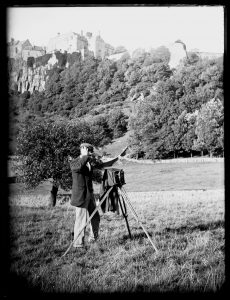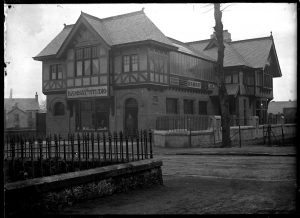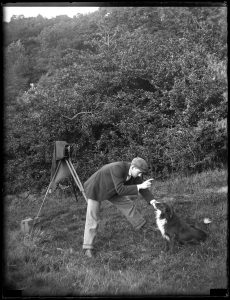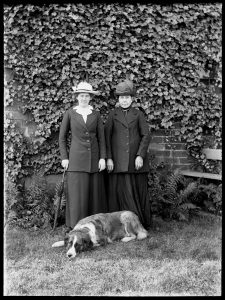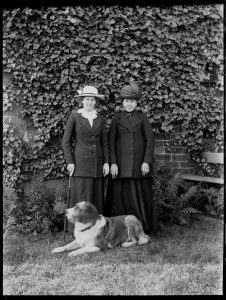Here at Stirling Archives we hold several glass plate negative collections. One of our most important collections comes from ‘Ramsay’s Studio’ who were based in Bridge of Allan. The studio was originally set up by Colin Ramsay and was situated on Union Street.
Before photographic film the main method of capturing an image was through glass plates. To do this glass plates were covered in a silver salt emulsion which were then exposed to light. The image would then be captured onto the glass plate.
Originally, photographers had to create their own ‘wet-coat’ for their glass plates but by the end of the 19th Century the process had evolved. ‘Dry’ glass plates could be acquired with pre-coated solutions making the practice quicker. By the time of ‘dry’ plates photographers only needed a few seconds of light to capture an image.
A common issue that photographers faced was movement of the subject. Unsurprisingly animals could be problematic. For example, if a dog moved its head when the plate was exposed to the light, the head could appear as a blur. An example of this can be seen below.
A great article by Sutton Archives (click here to see this) provides a comprehensive breakdown on the process used to capture an image. Ramsay’s Studio in Bridge of Allan would have used a similar process:
- Place a dry plate contained in a plate holder into a slot in the camera.
- Slide the cover from the plate holder to uncover the dry plate.
- Uncover and then recover the lens. By 1880 photographic plates were so sensitive that an exposure of less than a second was often enough to achieve the desired result.
- Slide the cover on the plate holder back over the dry plate.
- Remove the plate holder containing the exposed plate which was now ready for processing in a dark room.
Developing and Fixing the Negative
- Moisten the plate with distilled water.
- Place in a glass or gutta percha developing dish and cover with developing fluid.
- Wash thoroughly when image has appeared
- Place in a bath of fixing solution and then wash and dry the plate. It could also be varnished at this point but this was rare after about 1890
